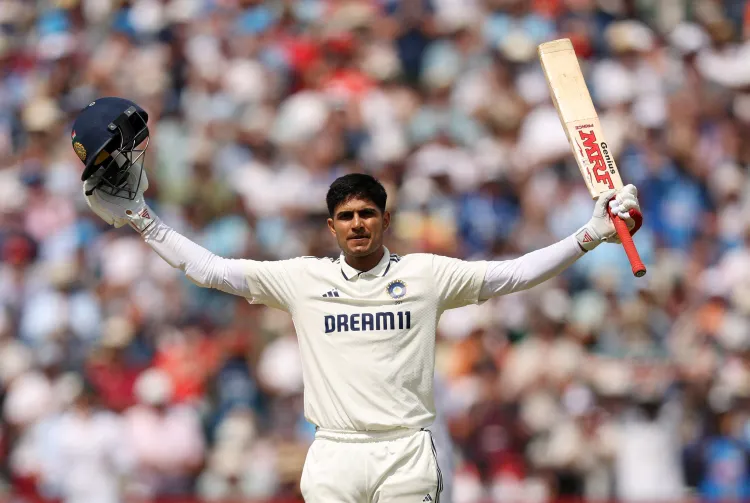What Did Shubman Gill Say About His Record-Breaking Double Ton?

Synopsis
Key Takeaways
- Shubman Gill's 269 runs were pivotal for India's total in the match.
- Emphasizing the joy of batting was crucial for Gill's turnaround.
- Returning to basics helped Gill regain his form.
- India's bowlers executed plans to control the game effectively.
- Gill's record-breaking innings set several benchmarks in cricket.
New Delhi, July 4 (NationPress) After an extraordinary innings that secured his place in cricket history, Shubman Gill shared insights into the technical adjustments and mental rejuvenation that propelled his stunning 269 runs against England at Edgbaston.
The 25-year-old Indian captain achieved a personal best in Test matches, lifting his team to a remarkable total of 587—marking their highest score in England in the past 18 years. This performance also saw the English team struggling at 77 for 3 by the end of Day 2.
Reflecting on his remarkable performance, Gill emphasized the importance of rediscovering the joy of batting, which played a pivotal role in revitalizing his form in the longest format of the game. “At times, when runs aren’t flowing, the enjoyment of batting diminishes. You become overly fixated on scoring. I realized that I had lost the joy in my batting. I was so focused that I wasn’t relishing the experience,” he expressed following Day 2.
As the newly appointed No. 4 batsman, who had faced a lull in his Test career prior to this series, Gill discussed how returning to fundamentals aided him in regaining his rhythm. “I primarily focused on my initial movements and overall setup. Before this, I believed my batting was progressing well, consistently scoring around 30-40 runs in Test matches. However, at a certain point, I missed that moment of peak concentration.
“Many say that excessive focus can sometimes lead to missing that peak time. Thus, during this series, I aimed to revert to my basics. I attempted to bat as I did in my younger days. I didn’t concentrate on reaching 35-40 runs or playing for long periods. I just wanted to savor my batting,” he added.
Gill’s exceptional innings made him the second youngest Indian captain, after Mansur Ali Khan Pataudi, to achieve a Test double century. He also became the first Asian captain to score a double hundred in SENA countries and the highest-scoring Indian Test captain, surpassing Virat Kohli's 254*. This marked India's first double century in away Tests since Kohli's achievement in 2016.
Despite the impressive statistics, Gill characterized the innings as anything but straightforward. “When I walked in to bat before lunch on the first day, I was at about 35-40 runs off roughly 100 balls by tea. I spoke with GG (Gautam Gambhir) Bhai, expressing my struggle to score freely, despite having many shots in my arsenal,” he recounted.
“I also sensed the ball was softer. In the previous match, I was scoring more smoothly, but this time it wasn’t as effortless. Nevertheless, my mindset was that if the pitch was favorable and I was set, I must not leave the match prematurely,” he emphasized.
This determination stemmed from lessons learned at Headingley, where Gill scored 147. “In the last match, I understood that regardless of how long you’ve batted, collapses can occur in the lower order under these conditions at any moment. So I aimed to stay at the crease for as long as possible. I wanted to be dismissed only by a good delivery and avoid making mistakes. That was my strategy,” he explained.
With England’s top order shaken by Akash Deep and Mohammed Siraj, India took charge of the Test match. Gill acknowledged his bowlers for adhering to their plans. “I believe that as the ball ages, taking wickets becomes more challenging. Therefore, the more we bowl consistently in one area and frustrate their batsmen, the better it is for us.
“We aim to restrict them to scoring in just one area. When a batsman can score freely all around the ground, it becomes difficult to manage them… I think our bowlers executed their strategies effectively. (The pitch) doesn’t provide a lot for bowlers, but there’s enough that if a batsman tries too hard, the chances of getting out increase.
“When a batsman attempts something different, their chances of getting out rise. Thus, we will aim to frustrate them while they bat, denying them opportunities to score runs. I believe that will be crucial for our bowling,” he concluded.









